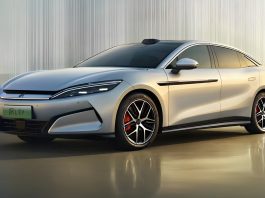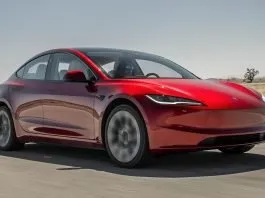In today’s world, you might have seen electric cars running on the road, all quiet and smooth. It’s quite obvious that they use electricity from batteries to move, right?
But believe it or not, making electric cars work like this is a real marvel of technology. These nifty cars are powered by electricity, making them a greener and more wallet-friendly choice.
They’re eco-friendly, leaving behind a tiny carbon footprint and sipping on little to no fossil fuels. Now, you might be wondering, “How do these magical machines work?”
They had to overcome many challenges to become so practical and usable. You see, we can’t directly store electricity, so electric cars store it in special chemicals inside a battery.
If you want to know how electric cars really work, we need to look closely at how these batteries function.
Let’s dive in and explore the fascinating world of electric vehicles!
Table of Contents
What Is An Electric Car?
At its core, an electric car is simply a vehicle that primarily relies on electricity for its propulsion. Believe it or not but electric cars or EVs are around for a long time. The first practical EV was invented by William Morrison in 1870 and popped everyone’s curiosity.
Unlike traditional cars that have engines and fuel tanks, electric cars are equipped with one or more electric motors to generate propulsion.
These motors are powered by a battery, much like the one you use in your smartphone, except much bigger in size. That’s why you often hear electric cars referred to as “EVs,” short for “electric vehicles.”
Unlike conventional internal combustion engine (ICE) vehicles that rely on burning fossil fuels to generate power, electric cars use electric motors powered by rechargeable batteries. These vehicles have become increasingly popular due to their eco-friendliness and potential to reduce greenhouse gas emissions, contributing to a cleaner and more sustainable future.
As technology continues to advance, electric cars offer not only a smoother and quieter ride but also considerable cost savings in terms of fuel and maintenance.
Types Of Electric Car
Electric cars come in various forms, including battery electric vehicles (BEVs) that run solely on electricity and plug-in hybrid electric vehicles (PHEVs) that combine an electric motor with a gasoline engine.
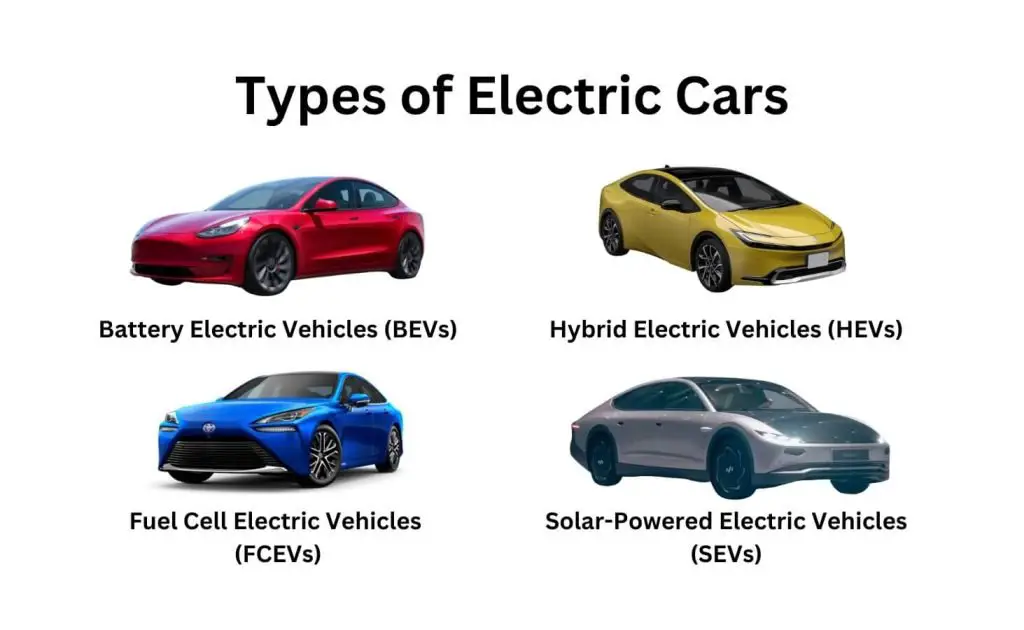
Types of electric cars:
Battery Electric Vehicles (BEVs)
A battery electric vehicle (BEV) is a type of electric car that runs only on electricity, with no gas or other fuel needed! It doesn’t have a regular engine like regular cars do. Instead, it has electric motors powered by big batteries inside the car.
These batteries are much bigger and have higher capacity compared to hybrid and plug-in hybrid electric vehicles. To drive a BEV, you need to charge it up first and you can do this at home with a charger or use fast charging stations. Some BEVs even recharge a bit when you hit the brake with regenerative braking.
While BEVs may cost more upfront due to their advanced battery technology, they are a fantastic choice for those looking for an eco-friendly and emissions-free ride. BEVs offer zero tailpipe emissions, making them the most environmentally friendly option.
Popular examples include all Tesla cars, Chevrolet Bolt EV, GMC Hummer EV, Ford Mustang Mach-e, Lucid Air, Nissan LEAF, Porche Taycan 4S, Audi e-Tron, BMW i3, Hyundai Ioniq, etc.
Hybrid Electric Vehicles (HEVs)
A hybrid electric vehicle (HEV) is a clever car that combines a regular internal combustion engine (like in traditional cars) with an electric motor and a battery pack. The purpose of this combination is to reduce the amount of fuel the car uses, making it more fuel-efficient.
The electric motor takes over when the regular engine would use more fuel, like when starting from a stop, and the regular engine kicks in when it’s more efficient, such as when cruising on the highway.
HEVs can be categorized into two types:
- Mild Hybrid Electric Vehicles (MHEVs)
- Full Hybrid Electric Vehicles (FHEVs)
HEVs are pretty similar to regular cars when it comes to driving them, and you can only fill them up with regular fuel, like petrol. (You cannot plug them in!)
The best part is that the HEV’s battery automatically charges itself through a cool process called “regenerative braking,” and the electric motor turns on when it’s needed.
So you don’t have to worry about charging the battery or plugging it into power outlets making it a smart and convenient way to save on fuel!
Popular HEVs include Audi A8 Le-tron, Ford Focus MHEV, Toyota Prius, Dodge Ram 1500 e Torque, Range Rover Evoque, etc.
Plug-in Hybrid Electric Vehicles (PHEVs)
A plug-in hybrid electric vehicle (PHEV) is a special kind of car that combines both an internal combustion engine (ICE) and an electric motor with a battery pack, similar to a regular hybrid car, but with some cool differences.
PHEVs have larger battery packs and more powerful electric motors, which means they can rely more on the electric system while driving. This allows PHEVs to be driven in electric-only mode, with the ICE turned off completely.
Driving a PHEV is quite similar to driving a regular hybrid, as the car automatically switches between using the electric motor and the ICE based on the driving conditions.
The cool thing is that with PHEVs, drivers have the option to recharge the battery by plugging it in, in addition to filling it up with fuel.
So, a PHEV can run solely on petrol if the battery charge is used up, and if all the fuel is used up, it can switch to running on battery charge alone. It’s like having the best of both worlds – the convenience of petrol and the eco-friendliness of electricity in one awesome car!
Fuel Cell Electric Vehicles (FCEVs)
Fuel cell electric vehicles (FCEVs) are a bit like battery electric vehicles (BEVs) because they also run on electricity. But how they store and get that electricity is different. While BEVs need to be charged with electricity from a charger, FCEVs make their own electricity through a special chemical reaction using hydrogen.
So, instead of plugging in to charge, FCEVs can be filled up with hydrogen, just like how regular cars are filled with gas.
It’s a cool and convenient way to power the car without relying on traditional fuels, making FCEVs a smart choice for those who want an eco-friendly ride without the hassle of charging. Toyota Mirai, Honda Clarity, BMW iX5, etc. are some popular FCEVs available in production.
Solar-Powered Electric Vehicles (SEVs)
Solar-Powered Electric Vehicles (SEVs) are a type of electric vehicle that incorporates solar panels to harness solar energy and use it to power the vehicle’s electric motor or recharge its battery. These vehicles have solar panels integrated into their roof or body, which capture sunlight and convert it into electricity through photovoltaic cells.
The electricity generated is then used to supplement the vehicle’s battery power, providing additional range and reducing the need for external charging.
While SEVs can’t solely rely on solar power for all their energy needs, as when the sun is out, what can you do? The vehicle works as an all-electric one in that scenario.
How Does An Electric Car Work?
An electric car works in a fascinating mechanism as instead of using gasoline, like regular cars, electric cars run on electricity. They have special batteries that store electrical energy, just like the ones in your smartphone, but much bigger.
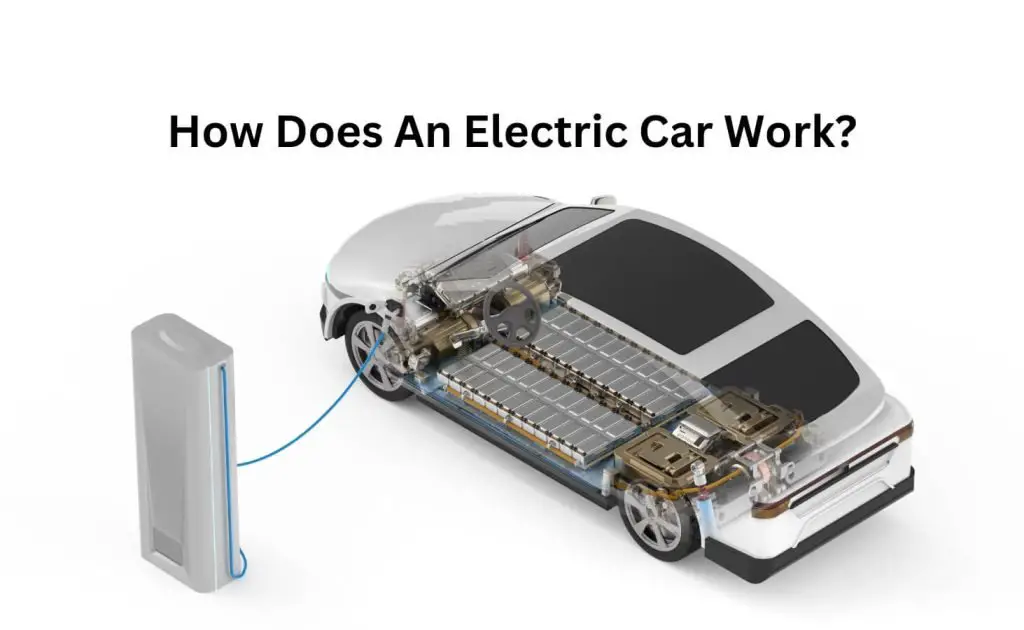
These batteries power electric motors inside the car, making it move. When you press the accelerator pedal, the electric motor gets going, and the car drives forward. Here’s the whole deal in a bit of detail.
How Do Batteries Work in Electric Cars?
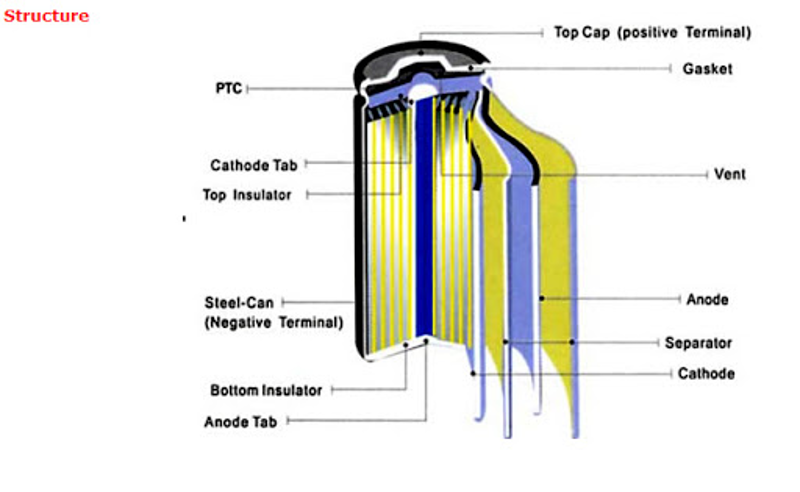
Inside a battery, there are three important parts: the cathode, the anode, and the electrolyte. The electrolyte acts as a separator between the cathode and the anode and also helps charged particles move between them, balancing the chemical potential.
When the battery is in use and discharging, the anode releases electrons to the negative terminal and the electrolyte in the form of ions.
Simultaneously, the cathode receives these electrons, closing the circuit and enabling the movement of electrons. This amazing process converts the stored chemical energy in the battery into useful electrical energy, generating the electric current that powers our devices and electric cars.
So, the battery acts as a little power plant in itself, turning chemical energy into the electricity we rely on every day.
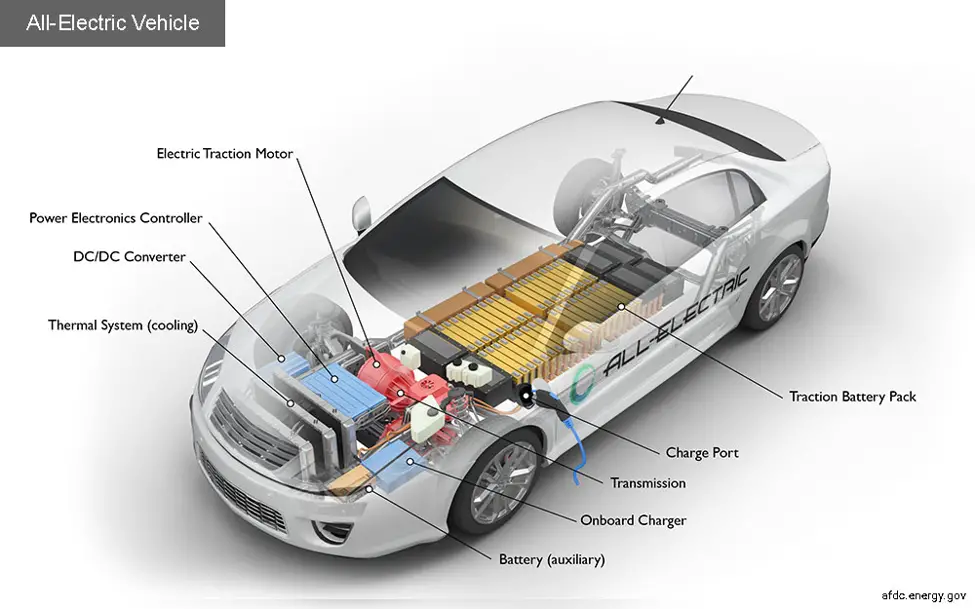
Key Components of an All-Electric Car
Over these years of continuous development of battery technology has led to a stage where we can have enough energy density in a battery to power a vehicle with good performance and practical ranges. The modern age batteries are mostly long metal spiral-shaped cases consisting of three thin sheets pressed together. Inside the case is the electrolyte, mostly organic ether in which the mentioned sheets are submerged.
Out of the three sheets, the one in the middle is a separator made up of micro-perforated plastic. The negative electrode is made of carbon while a positive electrode is made of lithium cobalt oxide. When in the charging state, the lithium ions in the battery move from the positive electrode to the negative electrode through the electrolyte while attaching to the carbon. Opposite to this during discharge, the lithium ions move back to the lithium cobalt oxide from the carbon.
Basically, every battery works on this very principle but the ability of lithium ions to store huge amounts of electrical energy in the form of chemical energy is what made it take a leap in battery technology. Hence electric cars were able to make the jump from novelty to reality. Another major advantage of lithium-ion batteries is that it can be recharged over and over and over again. The cells in the battery of an electric car are wired in the best possible combination of series and parallel to increase both Voltage and Amperage.

Battery (All-Electric Auxiliary)
A battery electric vehicle (BEV) has an All-Electric Auxiliary (AEA) battery, which is an additional battery system used to power various auxiliary functions in the car. While the main battery in a BEV is responsible for providing energy to the electric motor for propulsion, the AEA battery takes care of powering other components like lights, air conditioning, and entertainment systems.
By having a separate AEA battery, the BEV can efficiently manage and distribute the electrical load, ensuring that essential functions in the car continue to work even when the main battery is dedicated to driving the vehicle.
Charge Port
A charge port is a crucial component of an electric vehicle (EV) that serves as the entry point for recharging the vehicle’s battery. It is similar to a gas tank inlet in traditional cars but designed specifically for electric charging.
The charge port is typically located on the exterior of the EV and is equipped with various plug types, depending on the region and charging standards. When it’s time to charge the EV, the driver plugs in the charging cable to the charging port and then connects the other end to a charging station or power source.
DC/DC Converter
A DC/DC converter is a vital device in the world of electronics and electric vehicles. It serves as an intermediary between two electrical systems, converting one direct current (DC) voltage level to another. The converter plays a crucial role in various applications, such as in electric vehicles, where it facilitates the efficient transfer of power between the vehicle’s main battery pack and other subsystems like the auxiliary battery or the onboard electronics.
By adjusting the voltage level, the DC/DC converter ensures that the right amount of power is delivered to each component, optimizing energy efficiency and performance.
Electric Traction Motor
An electric traction motor is a key component in electric vehicles, responsible for driving the wheels and propelling the vehicle forward. It operates on the principle of electromagnetism, where the interaction between electric currents and magnetic fields generates motion.
When electricity is supplied to the traction motor, it creates a magnetic field that causes the rotor to turn, which, in turn, drives the wheels of the vehicle. The electric traction motor offers several advantages, including high efficiency, instant torque delivery, and smoother operation compared to traditional internal combustion engines.
Onboard Charger
An onboard charger is a crucial component in electric vehicles (EVs) that converts alternating current (AC) from a charging station or power outlet into direct current (DC) to efficiently recharge the vehicle’s battery pack. This process is essential because the EV’s battery needs DC power to store and utilize energy effectively.
The onboard charger is usually located within the vehicle and is connected to the charge port. When the EV is plugged in for charging, the onboard charger ensures that the electrical energy from the external power source is transformed into the correct voltage and current needed to recharge the battery.
The charging rate and capacity of the onboard charger can vary depending on the EV model, affecting the time it takes to fully recharge the battery.
Power Electronics Controller
A power electronics controller is a crucial device in electric vehicles (EVs) that manages the flow of electrical power between various components in the vehicle’s electrical system. It acts as the brain of the power electronics system, regulating the distribution and conversion of electric power to ensure the efficient operation of the EV.
The power electronics controller is responsible for controlling the electric traction motor, the onboard charger, and other auxiliary systems, such as the cooling system and battery management system. It monitors and adjusts the power flow to optimize performance, energy efficiency, and battery charging/discharging processes.
Thermal System (Cooling)
The thermal system, specifically the cooling system, is a crucial component in electric vehicles (EVs) that helps regulate the temperature of various critical components. In an EV, the batteries and electric traction motor generate heat during operation, and excessive heat can be detrimental to their performance and lifespan.
The cooling system is responsible for dissipating this heat and maintaining the optimal operating temperature. It uses a combination of liquid or air cooling methods to transfer the excess heat away from the battery pack and electric motor, preventing them from overheating.
Proper thermal management ensures that the components function efficiently and extend their overall lifespan.
Traction Battery Pack
The traction battery pack is one of the most important components in an electric vehicle (EV). It serves as the primary energy storage system, providing power to the electric traction motor that drives the vehicle. The battery pack is made up of multiple individual battery cells connected together in series and parallel configurations to achieve the desired voltage and capacity. These battery cells are usually lithium-ion or other advanced battery chemistries that offer high energy density and efficiency.
The traction battery pack is typically located on the floor of the EV to optimize weight distribution and improve the vehicle’s stability and handling. It is also equipped with a Battery Management System (BMS) that monitors the health, temperature, and state of charge of each battery cell, ensuring safe and optimal operation.
The size and capacity of the battery pack influence the driving range and performance of the electric vehicle.
Transmission (Electric)
In electric vehicles (EVs), the transmission system works quite differently from traditional gasoline-powered cars. Unlike the multi-gear transmissions found in conventional vehicles, electric cars often use a single-speed transmission or what’s known as a direct drive system.
This means electric vehicles don’t require complex gear shifting since electric motors provide instant torque, allowing for smooth and continuous acceleration without the need for multiple gears.
Working Principle of Electric Vehicle
Now having understood how the energy is stored in batteries lets move further learning how this energy can be used to get work done, that is in our case, make the car run. Another important fact is that wrapping wires and passing currents through them generate magnetic fields. This magnetic field generates a tangible physical force that is used in electric motors to actuate motion. As used in a Tesla Model S, the electric motor used is an Induction motor.
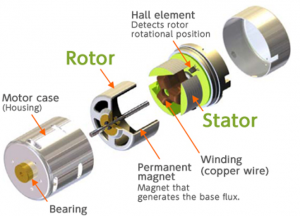
This motor has two parts: the Rotor and the Stator. The rotor is a series of conduction bars short-circuited by end rings. A 3 phase AC pulse is given to the stator producing a 4-pull rotating magnetic field. When electricity passes through the stator, it induces an electric current on the metal bars of the rotor. Hence the rotation field caused by the stator causes the now charged rotor to set in motion. The frequency of the AC current through the stator determines the speed of the rotor.
In the case of an electric car, pressing the accelerator pedal actually increases the frequency of the current. An inverter installed in this setup just beside the motor and its purpose is to switch the direct current from the batteries to an alternating current needed for the motor. It also controls the frequency and amplitude of the current, affecting the motor’s power output. This depends on a variable frequency drive. All this setup actually does not makes any contact except the bearings that keep the rotor in place.
This no-contact setup prevents any wear between the rotor and the stator. All this results in a useful torque that can be seen up-to a rev range of 18000 RPM, eliminating the use of gears or torque converters. Other benefits include much better efficiency as there are fewer moving parts, a significant reduction in weight of the motor replacing the engine, but there is a massive battery pack that is situated at the bed of the car also helping in improving the car handling and dynamics.
One of the biggest concerns in electric cars is discharging all the energy in the battery, and high RPM spinning rotors is the generation of heat. All the systems are coupled with a liquid cooling system preventing overheating. Then there is the regenerative braking. Each induction motors when not rotating the wheels can be spun by the wheels when they are rolling and breaking, making the motor act like an alternator which in return charges the battery.
How To Charge An Electric Car?
Charging an electric car is a straightforward process, and there are different options available depending on your charging needs and the charging infrastructure available in your area.
Ways to Charge an EV
- Level 1 Charging
- Level 2 Charging
- DC Fast Charging
Level 1 Charging
Level 1 charging is the most basic and accessible method of charging an electric car. It involves using a standard household electrical outlet, typically 120 volts in North America. Most electric vehicles come with a Level 1 charging cord that you can plug directly into a standard outlet.
However, Level 1 charging is relatively slow and is best suited for overnight charging or for those who drive short distances and have plenty of time to charge their vehicle. But overnight home charging is enough to get you a 40-50 mile run around the city.
Level 2 Charging
Level 2 charging provides a faster charging option for electric vehicles. It uses a 240-volt electrical outlet, similar to what’s used for electric dryers or ovens in homes. Level 2 charging stations are commonly found in public charging stations, workplaces, and residential charging installations.
Using a Level 2 charging station, you can charge your electric car significantly faster than with Level 1, making it more convenient for daily charging needs. You can get 40 miles for your daily commute in under two hours using Level 2 charging.
DC Fast Charging
DC fast charging is the quickest charging option for electric vehicles. It uses direct current (DC) to rapidly charge the vehicle’s battery, allowing you to add a substantial amount of range in a short time.
DC fast charging stations are usually located along major highways and busy travel routes, enabling long-distance travel for electric cars. These fast chargers are capable of charging an EV’s battery to 80% or more in around 20-30 minutes, depending on the vehicle model and battery capacity.
When charging your electric car, it’s essential to use the appropriate charging equipment and follow safety guidelines.
Many electric cars now come with mobile apps or online platforms that allow you to monitor and schedule charging remotely, making it even more convenient to keep your EV charged and ready for your daily journeys.
Benefits Of Electric Cars
Electric cars offer numerous benefits that make them an attractive and eco-friendly choice for modern transportation. Key advantages of electric cars:
Environmental Friendliness
Electric cars produce zero tailpipe emissions, which means they do not release harmful pollutants or greenhouse gases into the atmosphere. By driving an electric car, you can significantly reduce your carbon footprint and help combat air pollution and climate change.
Reduced Operating Costs
Electric cars are lower in maintaining and operating costs compared to ICE vehicles. Electricity is generally cheaper than gasoline, and electric cars have fewer moving parts, reducing maintenance and repair expenses over time.
Energy Efficiency
Electric motors are highly efficient, converting a larger portion of the energy from the battery to power the wheels. This results in better energy efficiency and longer driving ranges for electric cars.
Quiet and Smooth Ride
Electric cars are much quieter and provide smoother acceleration compared to conventional vehicles with internal combustion engines. This contributes to a more pleasant and peaceful driving experience.
Home Charging Convenience
Electric cars can be charged conveniently at home using a standard electrical outlet or a Level 2 charging station. This eliminates the need for frequent trips to the gas station and allows for hassle-free charging overnight.
Regenerative Braking
Many electric cars are equipped with regenerative braking technology, which captures and stores energy during braking, increasing the overall efficiency and extending the driving range.
Incentives and Rebates
Many governments and local authorities offer incentives, tax credits, and rebates to encourage the adoption of electric vehicles. These incentives can help reduce the upfront cost of purchasing an electric car.
Quiet and Clean Urban Mobility
Electric cars are particularly well-suited for urban environments, where air quality and noise pollution are major concerns. Their quiet and clean operation can contribute to improved urban living conditions.
Technological Advancements
As electric vehicle technology continues to evolve, advancements in battery technology, charging infrastructure, and range capabilities make electric cars an increasingly practical and viable choice for daily commuting and long-distance travel.
Overall, electric cars present a compelling case for a sustainable and efficient mode of transportation, offering benefits to both drivers and the environment. As the technology continues to improve and charging infrastructure expands, electric vehicles are becoming an integral part of the transition to a greener and more sustainable future in the automotive industry.
Disadvantages Of Electric Cars
While electric cars have numerous advantages, they also come with some drawbacks that may affect their widespread adoption. One significant disadvantage is the limited driving range compared to traditional gasoline-powered vehicles.
Although modern electric cars have improved ranges, some models may still not be suitable for long-distance travel without frequent charging stops. Also, the availability of charging infrastructure can be a challenge, especially in remote or rural areas. Charging an electric car can take longer than refueling a gasoline car, leading to some inconvenience for drivers with busy schedules.
The initial cost of purchasing an electric car is often higher than that of a comparable gasoline-powered vehicle, although ongoing operational savings may offset this over time.
While electric vehicles have a smaller carbon footprint during operation, the environmental impact of manufacturing and disposing of their batteries remains a concern.
Despite these disadvantages, ongoing advancements in technology and increasing awareness of environmental benefits are expected to address some of these issues and make electric cars an even more attractive option in the future.
What To Expect In The Future?
In the coming years, we can look forward to a transformative shift in the automotive landscape, driven by the evolution of electric vehicles and sustainable transportation.
As the charging infrastructure expands rapidly, drivers can expect the convenience of more public charging stations and fast-charging networks, ensuring that electric vehicles can be powered up easily and conveniently. Tesla alone has a vast network of Superchargers on a global scale including as many as 45,000 superchargers.
The future will witness a significant increase in the affordability and market penetration of electric vehicles, making them a mainstream choice for environmentally-conscious consumers. Moreover, the convergence of electric and autonomous driving technology will revolutionize the way we travel, promising safer and more efficient journeys.
With a focus on renewable energy integration and vehicle-to-grid technology, electric cars will not only reduce emissions but also contribute to a more resilient and sustainable energy grid.
Many automakers are working on future tech including hydrogen-based and solar-based vehicles that are sure to make a significant mark.
As the automotive industry embraces sustainable materials and eco-friendly manufacturing processes, the rise of electric fleets will further propel the green mobility revolution, reshaping the way we move and envisioning a cleaner and greener future for transportation.
Bottomline
In conclusion, the future of transportation looks really exciting and good! Electric vehicles will be a big part of it, making our rides more eco-friendly and convenient. They’ll have better batteries, faster charging, and will be cheaper too.
We’ll see more charging stations everywhere, making it easy to power up our electric cars. Plus, self-driving cars will make our journeys safer and smoother not just the Autopilot version but better.
Electric vehicles will not only help reduce pollution but also work with renewable energy to make our power grid better. The car industry is also making sure to use eco-friendly materials and methods to build electric cars.
With electric fleets becoming more common, we’re moving towards a cleaner and greener future for transportation. Get ready for a world where electric cars lead the way to a cleaner and better future for everyone!
FAQs
Electric cars charge their batteries while driving through a process called regenerative braking. When the driver applies the brakes, the electric motor acts as a generator, converting the kinetic energy of the moving car into electrical energy, which is then used to recharge the battery.
No, most electric cars do not have gears like traditional gasoline-powered cars. Electric vehicles typically use a single-speed transmission, also known as a direct drive system, which eliminates the need for gear shifting due to the instant torque delivery of electric motors.
Yes, electric cars have brakes just like traditional gasoline-powered cars. They use regenerative braking, which allows the electric motor to act as a generator and convert kinetic energy back into electrical energy to recharge the battery while slowing down the vehicle. In addition to regenerative braking, electric cars also have conventional mechanical brakes for more significant braking and emergency situations.
Yes, electric cars are automatic, and most of them do not have traditional manual transmissions like gasoline-powered cars. Electric vehicles typically use a single-speed transmission, making them easier to drive as there is no need for gear shifting.
The lifespan of electric vehicle (EV) batteries can vary, but on average, they are designed to last around 10 to 20 years or more, depending on factors like usage, charging patterns, and battery chemistry. Many manufacturers offer warranties on EV batteries for a certain number of years or miles to ensure their longevity and performance.
Range Anxiety. One of the main challenges with electric cars is their limited driving range compared to traditional gasoline-powered vehicles, which can cause range anxiety for some drivers. Also, the availability of charging infrastructure and the time it takes to charge an electric car can be a concern, especially for long-distance travel.
Electric cars do experience some battery drain while parked, but it is typically minimal. Maybe 2-3% a month. However, the exact amount of charge lost depends on various factors, such as the car’s battery management system, ambient temperature, and any accessories or systems running while parked.
The cost to replace an electric car battery can vary significantly depending on the make and model of the electric vehicle and the battery capacity. On average, it can range from $5,000 to $20,000 or more, but some manufacturers offer battery warranties that cover replacements within a certain period or mileage limit.
The cost of a Tesla battery depends on the specific model and battery capacity. So, for the basic entry-level Model 3, you can expect the price of a Tesla battery pack replacement from around $13,000 onwards. For other models from the Tesla fleet, you can expect the prices to go up to $20,000 or even more.
Electric cars are easy to use due to their simplified drivetrain, automatic transmissions, and instant torque delivery, making acceleration smooth and responsive. The thing is that electric vehicles have fewer moving parts, leading to reduced maintenance needs and a user-friendly driving experience with fewer complexities compared to our traditional gasoline-powered cars.
Electric vehicles are considered pretty safe and undergo rigorous safety testing to meet industry standards. Tesla Model S and Tesla Model X have 5-star safety ratings in all categories of NHTSA safety ratings.
EVs often have lower centers of gravity due to the battery placement, reducing the risk of rollover accidents, and advanced safety features to protect occupants and pedestrians, making them comparable to traditional gasoline cars in terms of safety.
Yes, electric cars are known for their high efficiency as they convert a larger portion of energy from the battery into power for the wheels, resulting in reduced energy waste and better overall efficiency compared to traditional gasoline-powered cars. Moreover, electric motors provide instant torque, making electric vehicles efficient in city driving and stop-and-go traffic.
Yes, electric cars are generally faster in terms of acceleration compared to traditional gasoline-powered cars, thanks to the instant torque delivery of electric motors, providing quick and responsive acceleration from a standstill. However, top speeds and overall performance can vary depending on the specific electric vehicle model and battery capacity. Did you know Tesla Model S can do 0 to 60 miles in under 2 seconds? Yes. It can!s in under 2 seconds? Yes. It can!

